Lead nurturing is not about making a sale. It's about building a relationship with potential customers and guiding them through their journey.
Lead nurturing is a critical component of any successful marketing strategy. It involves building and maintaining relationships with potential customers through continuous engagement and personalized interactions. The ultimate goal is to guide these prospects through the buying process, increasing their likelihood of conversion and fostering long-term customer loyalty.
Popups play a pivotal role in this process. They can be seamlessly integrated into a lead nurturing strategy to capture attention, deliver targeted content, and prompt action. By utilizing popups effectively, businesses can enhance their lead generation efforts and ensure that prospects receive the right message at the right time.
Why Popups Are Essential for Lead Nurturing
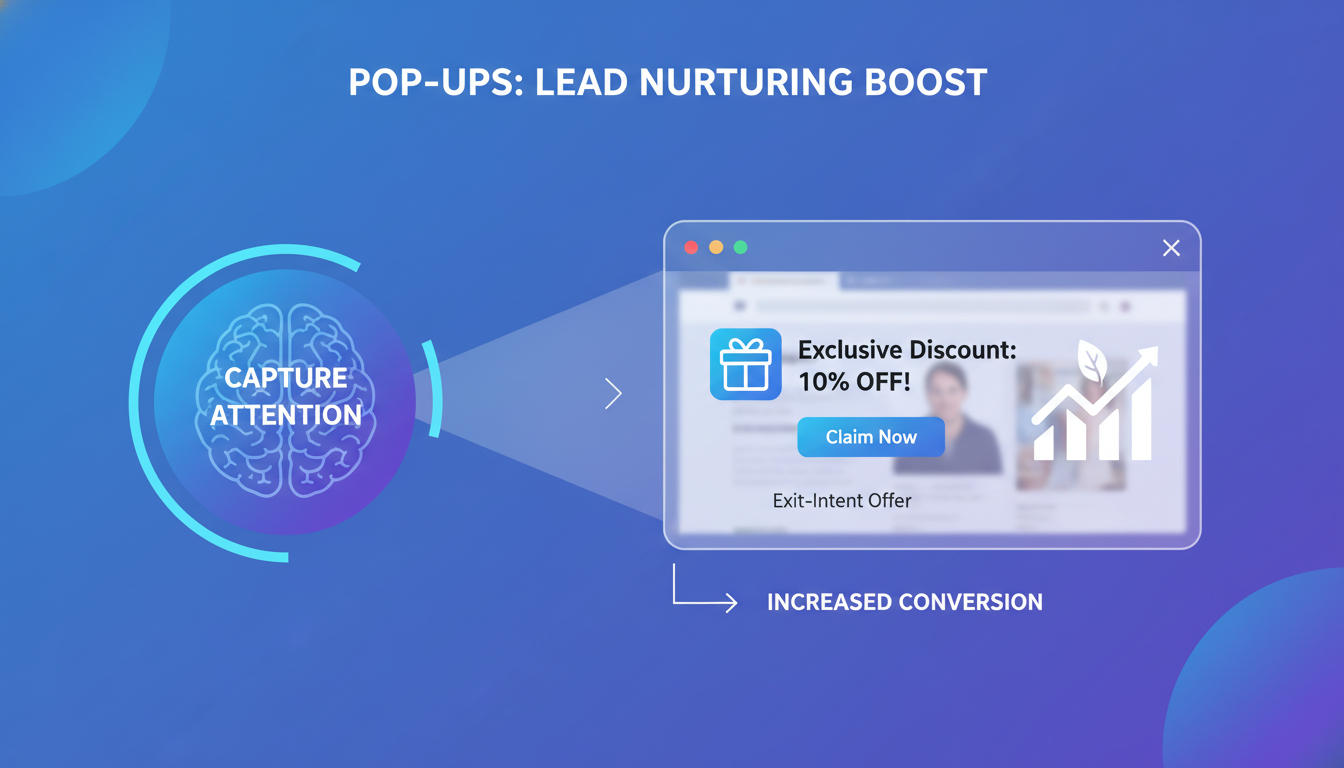
Capturing Attention at the Right Time
Popups are powerful tools for capturing user attention when they are most likely to engage. The psychological impact of popups lies in their ability to disrupt the user's current activity and offer something valuable. By displaying popups at key moments, such as when a user is about to leave the site or after they have been browsing for a while, you can ensure that your message reaches them when they are most receptive.
Engaging users with timely popups can significantly enhance the effectiveness of your lead nurturing efforts. For instance, an exit-intent popup offering a discount can persuade a visitor to complete their purchase rather than leaving the site.
Building a Direct Communication Channel
Popups facilitate direct interaction between users and businesses. They create a communication channel that can be used to gather feedback, answer questions, and provide personalized offers. This direct interaction not only enhances the user experience but also helps build a relationship with potential customers. By using popups to prompt conversations and collect contact information, businesses can create a more engaged and responsive audience.
5 Types of Popups for Lead Nurturing
Popups come in various forms, each serving a specific purpose in the lead nurturing process. Understanding the different types of popups and when to use them is crucial for building an effective strategy.
Exit-Intent Popups

Exit-intent popups are triggered when a user is about to leave your website. These popups track mouse movements and detect when the visitor is close to exiting the page, allowing you to deliver one final message before they go. This can be an offer, a lead magnet, or simply a reminder to subscribe to your newsletter.
Why they work: Exit-intent popups are effective because they give you one last opportunity to engage with visitors who might not return. By offering something valuable, you can capture leads that would otherwise be lost.
Timed Popups
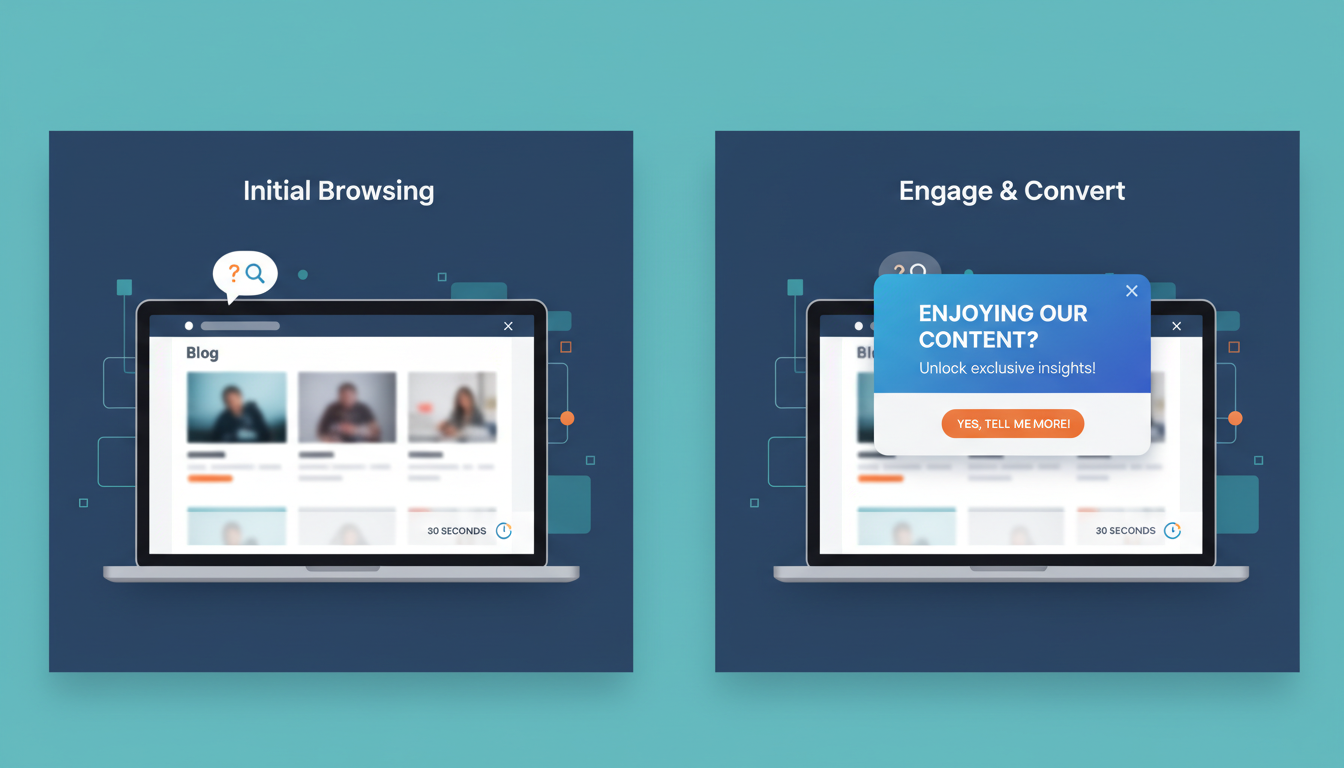
Timed popups appear after a user has spent a specific amount of time on your site. The idea is to engage users after they’ve had enough time to browse and show interest in your content.
Scroll-Based Popups
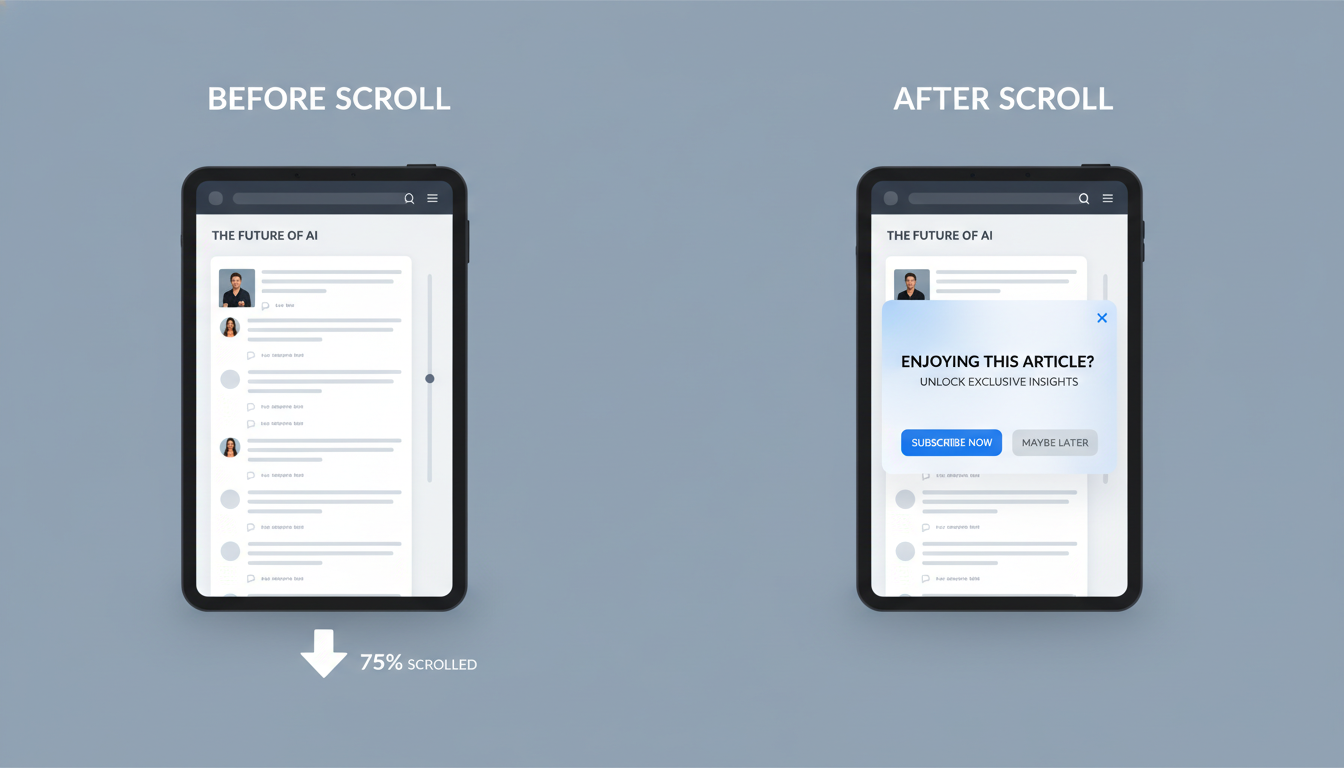
Scroll-based popups are triggered when a user scrolls down a certain percentage of the page. These popups are ideal for content-heavy pages like blogs, where users are likely to be deeply engaged by the time they reach a certain point.
Click-Activated Popups

Click-activated popups appear when a user clicks on a specific element, such as a button or a link. This type of popup is highly effective for gathering leads without disrupting the user experience, as it only appears when the user takes an intentional action.
Why they work: These popups are triggered by the user’s own behavior, making them feel more natural and less intrusive. They can be used for offering lead magnets, forms, or gated content.
Slide-In Popups
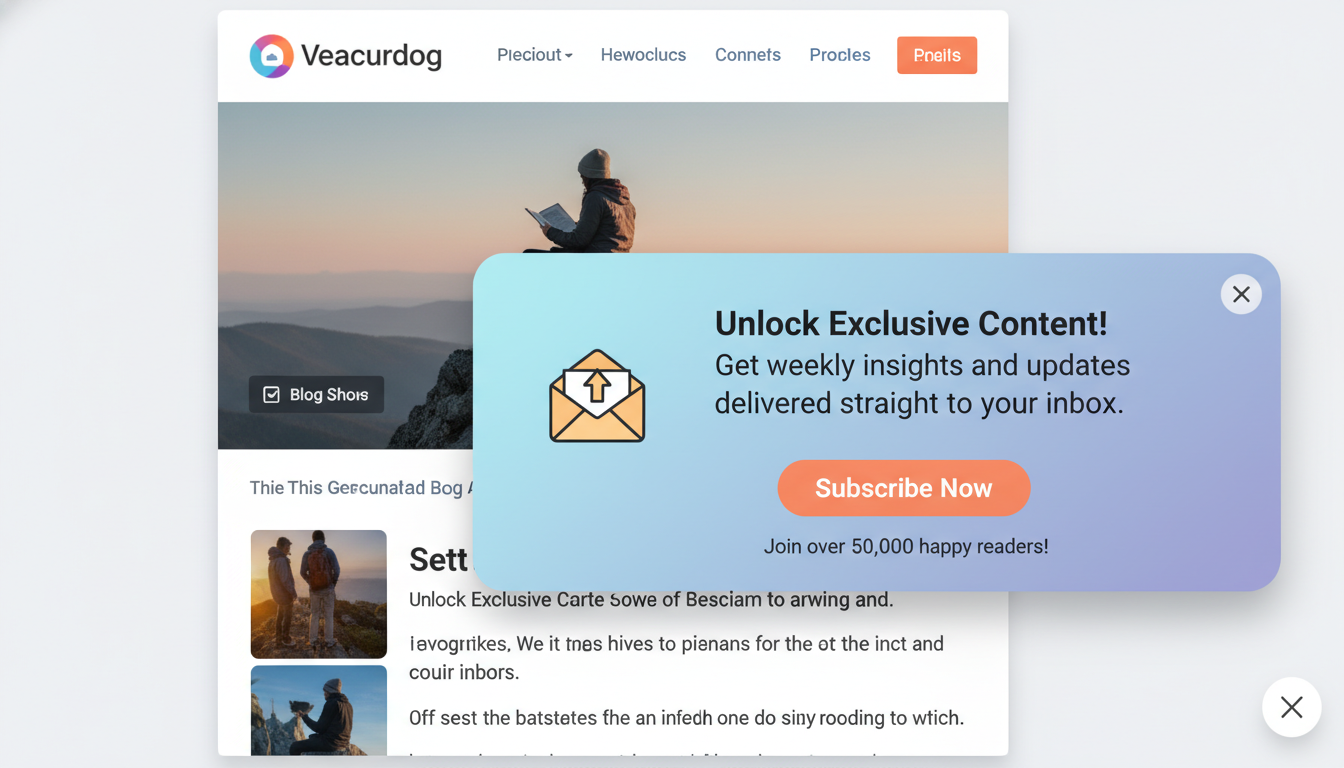
Slide-in popups appear subtly from the side or bottom of the screen, making them less intrusive than other popup types. They work well for providing non-urgent information or as a gentle reminder for users to take action.
Why they work: Because of their non-intrusive nature, slide-in popups don't disrupt the user experience while still grabbing attention. They are ideal for promoting blog subscriptions, announcing discounts, or showcasing lead magnets.
Benefits of Using Popups for Lead Nurturing
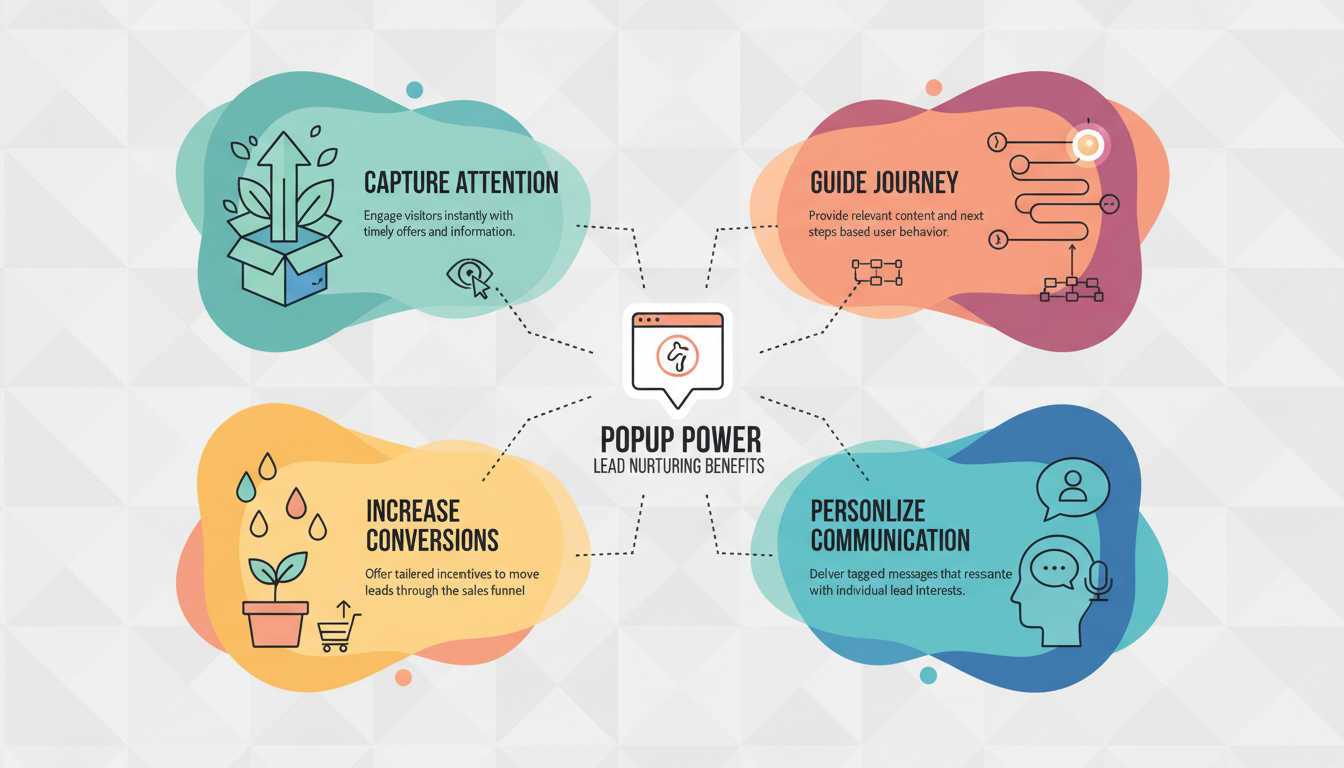
Popups, when used strategically, offer several benefits that make them a powerful tool for nurturing leads throughout their buyer’s journey. Let’s break down the key advantages of integrating popups into your lead nurturing strategy.
Increased Lead Generation
Popups are highly effective in capturing leads by presenting offers or forms directly to users. Whether it’s a newsletter subscription, a discount offer, or gated content like an eBook or webinar, popups provide an excellent way to convert visitors into leads. Unlike static lead generation forms, popups actively engage users and prompt them to take action, leading to higher conversion rates.
How popups boost lead generation:
Popups grab attention at key moments.
Exit-intent popups help recover visitors who may have otherwise left without converting.
Timed popups engage users after they’ve spent time exploring your site.
Example:
| Popup Type | Conversion Rate Increase |
|---|---|
| Exit-Intent Popup | 25% more leads captured from visitors about to leave |
| Timed Popup | 15% increase in newsletter subscriptions after 30 seconds on page |
Enhanced User Engagement
Popups help maintain user engagement by delivering personalized messages, offers, or content at the right time. By tailoring popups to specific user behavior (e.g., time spent on page or scrolling), businesses can keep users interested and increase their interaction with the site. Personalized popups with relevant offers make the user feel valued, encouraging them to spend more time on the website.
Improved Conversion Rates
Well-designed popups can significantly enhance your conversion rates by offering compelling CTAs (calls-to-action) and value propositions. By nurturing leads with timely offers, popups encourage users to take the next step, whether it’s signing up for a demo, downloading a resource, or making a purchase.
Best Practices for Designing Lead Nurturing Popups

Designing popups that capture attention and drive conversions requires a blend of aesthetics, functionality, and strategy. Follow these best practices to ensure your popups are optimized for lead nurturing success.
Clear, Concise Messaging
A popup’s effectiveness hinges on its message. Users are bombarded with information online, so your popup needs to communicate its offer clearly and concisely. The message should be direct and focused on value, immediately conveying why the user should take action.
Attractive Visual Design
First impressions matter, and the design of your popup plays a crucial role in its success. A visually appealing popup can capture attention, while a poorly designed one might be dismissed immediately. Ensure your popup aligns with your website’s branding and uses engaging visuals to draw users in.
Strong Call-to-Action (CTA)
The Call-to-Action (CTA) is the heart of your popup. It’s the driving force behind conversions, guiding users on what to do next. A strong CTA is action-oriented, specific, and creates urgency. Make sure your CTA stands out and directly correlates with the value you’re offering.
Crafting a powerful CTA:
Use active verbs like “Get,” “Download,” or “Join.”
Create a sense of urgency with phrases like “Limited Offer” or “Only Today.”
Position the CTA button prominently in the popup, ensuring it’s impossible to miss.
Example CTA:
| Weak CTA | Strong CTA |
|---|---|
| "Submit" | "Get My Free Guide Now!" |
Mobile-Responsive Design
In today’s mobile-first world, your popups must be mobile-responsive to ensure a seamless experience for users on all devices. A popup that doesn’t display correctly on mobile can frustrate users, leading to higher bounce rates and lower engagement.
Mobile design tips:
Ensure your popup is optimized to fit smaller screens without cutting off essential content.
Use mobile-friendly triggers like scroll or exit-intent that don’t interrupt the user experience.
Reduce popup size on mobile devices to avoid overwhelming the screen.
How to Personalize Popups for Lead Nurturing
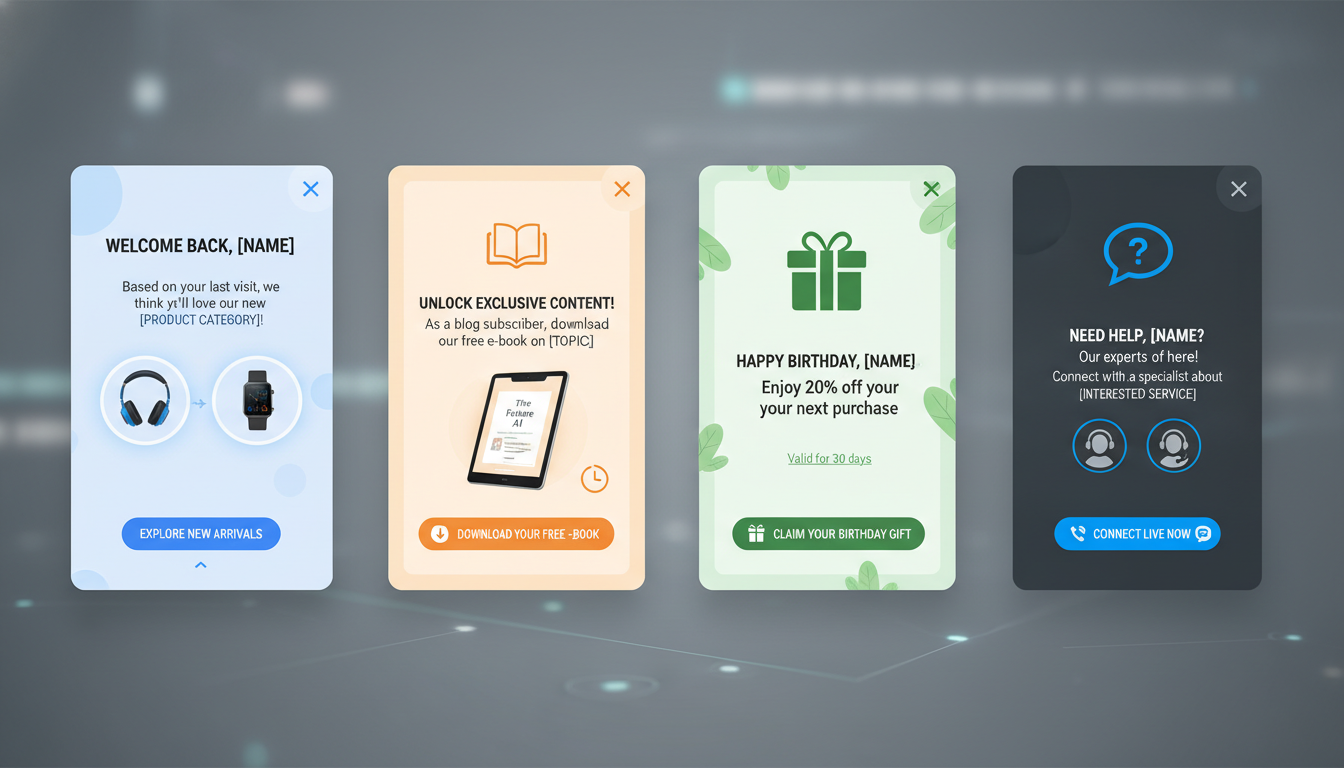
Personalization is the cornerstone of effective lead nurturing. When done right, personalized popups create a tailored experience that speaks directly to each user, increasing engagement and conversion rates. By utilizing customer data, businesses can deliver targeted popups that cater to the individual’s needs, preferences, and behavior.
Using Customer Data for Personalized Experiences
To create a personalized popup experience, it’s essential to leverage customer data such as:
Browsing behavior: Track which pages users visit and how they interact with your site. This data can help craft relevant popups, like recommending products or offering relevant content.
Previous interactions: Use information from past visits or purchases to show users popups that align with their preferences. For example, if a visitor has abandoned their cart in the past, show them an exit-intent popup offering a discount.
Demographic information: Personalize popups based on location, language, or other demographics. For example, showing location-based offers can be highly effective for geo-targeted campaigns.
Dynamic Content in Popups
Dynamic content allows your popups to change based on user interactions, providing a more relevant experience. This flexibility is powerful for lead nurturing, as users feel the content is directly speaking to their needs.
Personalization Strategies for Different Popup Types
Depending on the type of popup and the stage of the customer journey, here are some personalization strategies you can implement:
Exit-Intent Popups: For users who are about to leave, personalize the popup with a message like, “Before you go, grab this 20% discount!” Use urgency to encourage them to stay and take action.
Scroll-Triggered Popups: Show personalized recommendations based on the section of the page the user is engaging with. If they’re reading a blog on lead generation, offer a free guide on improving lead conversion.
Timed Popups: Tailor your timed popups based on user activity. For example, after a user has spent 30 seconds on a product page, display a popup offering a special discount or additional product information.
Benefits of Personalized Popups for Lead Nurturing
Higher Engagement Rates: Personalized popups are more relevant and engaging, making users more likely to interact with them.
Increased Conversion Rates: Users are more likely to convert when the content of the popup aligns with their specific needs and preferences.
Improved Customer Relationships: Personalization shows that you understand your audience, which fosters trust and loyalty.
Using Popups for Different Stages of the Lead Nurturing Funnel
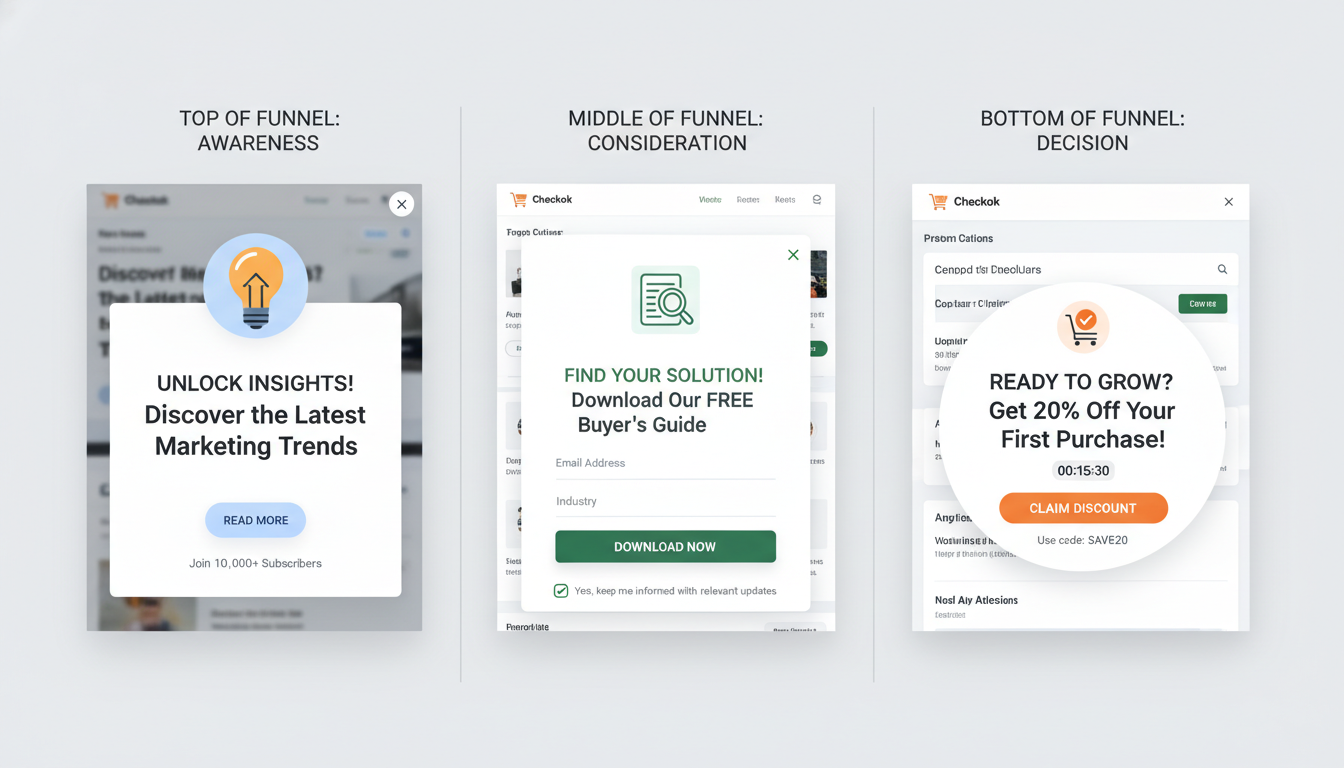
Lead nurturing requires a tailored approach at each stage of the marketing funnel, and popups can play a critical role in engaging potential customers at every step. From raising awareness at the top of the funnel to converting leads at the bottom, popups help guide users down the path to becoming loyal customers.
Top-of-Funnel (TOFU) Popups
At the top of the funnel, the goal is to capture attention and build awareness. Your audience may not yet be familiar with your brand, and they are typically in the early research phase, trying to understand their needs or problems. Popups at this stage should focus on providing value without asking for too much commitment.
Middle-of-Funnel (MOFU) Popups
Once leads are familiar with your brand and have engaged with your initial offers, they move to the middle of the funnel. Here, they are evaluating solutions and considering their options. MOFU popups should aim to nurture the relationship further, providing educational content or offers that move them closer to a decision.
Bottom-of-Funnel (BOFU) Popups
At the bottom of the funnel, your leads are ready to make a decision, and the goal is to convert them into customers. BOFU popups should include offers that encourage users to take the final step. These offers could be discounts, free trials, or time-sensitive promotions that create a sense of urgency.
Funnel Stages and Popup Goals
| Funnel Stage | Popup Strategy | Goal |
|---|---|---|
| TOFU | Lead magnets (e-books, guides) | Raise awareness and capture emails |
| MOFU | Webinars, case studies, product demos | Nurture leads and build trust |
| BOFU | Discounts, coupons, free trials | Convert leads into paying customers |
Customizing Popups for Each Stage
Understanding where your leads are in the funnel is essential to crafting the right popup experience. TOFU popups should focus on building relationships, MOFU popups should educate and nurture trust, and BOFU popups should provide the final push needed to convert leads into paying customers.
Here are some tips for customizing your popups based on funnel stage:
Use segmented popups: Segment your audience based on their behavior and where they are in the funnel. This allows you to deliver more targeted and effective popups.
Match the offer to the user’s intent: TOFU popups should focus on value-based offers like e-books, while BOFU popups should be geared toward driving conversions with discounts or trials.
Create urgency at the bottom of the funnel: Adding urgency, such as a time-limited offer, is especially powerful for BOFU popups.
How Poper Can Help with Lead Nurturing Popups
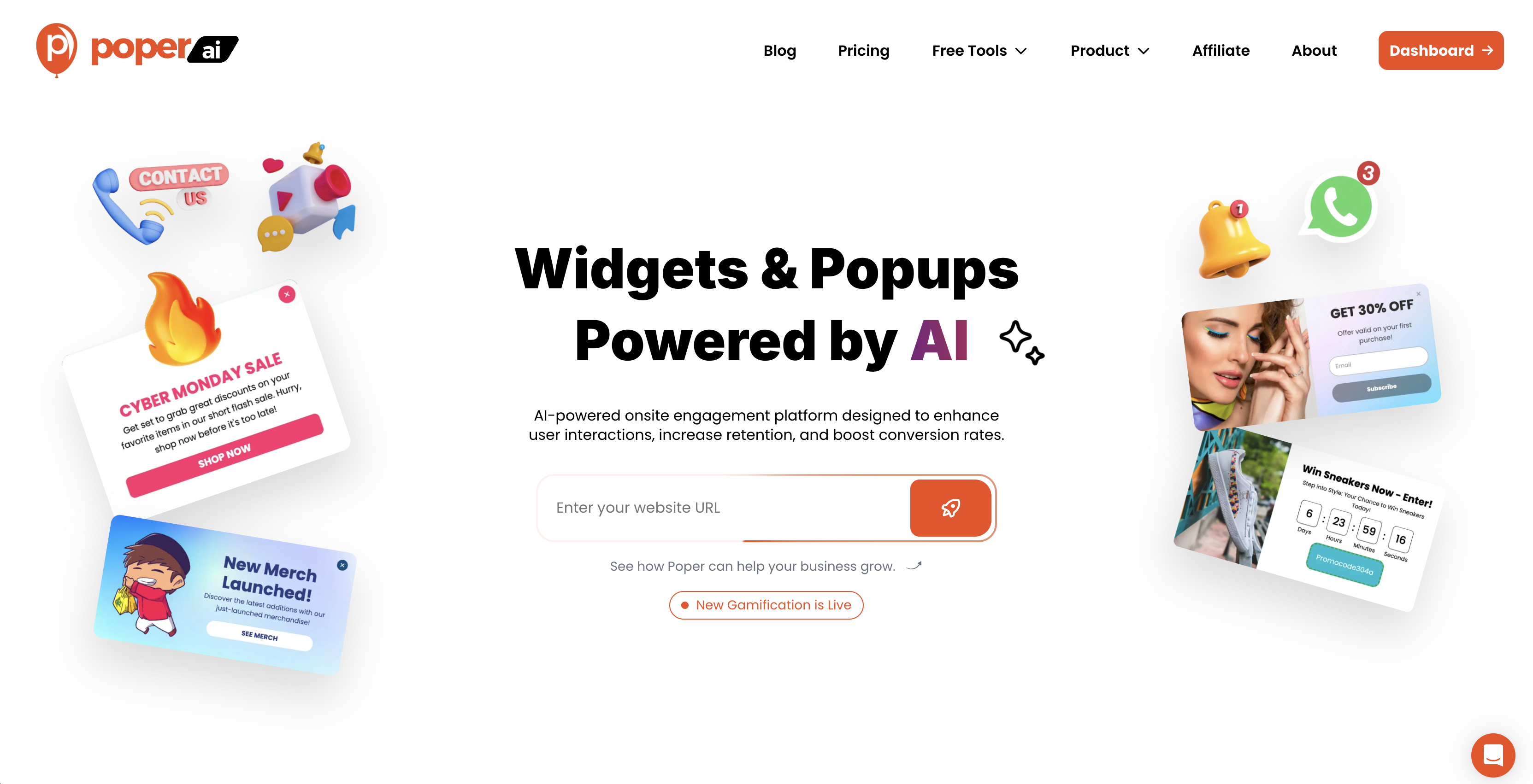
Poper is designed to take your lead nurturing efforts to the next level by offering a range of powerful tools to create, manage, and optimize popups. Here's how Poper can help you streamline the process and enhance engagement:
1. AI-Driven Personalization
Poper leverages AI to deliver personalized popups based on user behavior, demographics, and browsing patterns. With dynamic content, you can ensure that every visitor gets a tailored experience, leading to higher engagement and conversion rates.
2. Advanced Targeting Options
Using precise targeting, Poper allows you to display popups based on specific triggers such as exit intent, user activity, or scroll percentage. This ensures that your popups appear at the perfect time, capturing attention without disrupting the user experience.
3. Easy-to-Use Builder
Poper offers a drag-and-drop builder that allows anyone to design stunning popups without needing coding skills. You can quickly create popups for different stages of the lead nurturing funnel, from top-of-funnel awareness to bottom-of-funnel conversion.
4. Pre-Built Templates
If you're short on time, Poper provides a variety of pre-made templates specifically designed for lead generation, exit-intent popups, or timed popups. These templates are customizable, helping you match them to your branding and goals.
5. A/B Testing and Analytics
To optimize your popup campaigns, Poper includes A/B testing functionality. You can test different variations of your popups, headlines, and CTAs to see which version performs best. The built-in analytics further help track metrics like conversion rate, click-through rate, and engagement time, enabling you to refine your strategy continuously.
6. Mobile-Responsive Design
With more users browsing on mobile, Poper ensures that your popups are fully mobile-optimized, providing a seamless experience across devices. This ensures you don’t miss out on nurturing leads who are visiting from mobile platforms.
7. Seamless Integrations
Poper integrates easily with CRM systems, email marketing tools, and other platforms, allowing you to capture leads and automatically funnel them into your sales pipeline or nurture sequences.
FAQs: Your Most Pressing Popup Questions Answered
What is the best type of popup for lead nurturing?
The best type of popup for lead nurturing depends on your goals and audience. Exit-intent popups are highly effective for recovering abandoned carts or capturing leads before visitors leave. Timed popups are great for encouraging engagement after a certain duration, while scroll-based popups work well for users who have shown interest by scrolling down the page.
What are the most common mistakes in popup campaigns?
Some common mistakes include showing popups too frequently, poor timing, using irrelevant messaging, and not optimizing for mobile devices. Avoid overwhelming users with too many popups, especially when they are irrelevant or repetitive. It’s also important to ensure that your popups are responsive and offer a seamless experience across all devices.
How can I measure the effectiveness of my popup lead nurturing strategy?
To measure popup effectiveness, focus on key metrics like conversion rate, click-through rate (CTR), engagement time, and bounce rate. A/B testing different popup variations helps determine which design, message, or CTA performs best. Tools like Poper’s built-in analytics can provide detailed insights into user interactions and popup performance.
Why is it important to follow GDPR regulations with popups?
GDPR compliance is crucial to ensure that you respect user privacy and avoid legal issues. Popups that collect personal information, such as email addresses or names, must include a clear consent mechanism. You should also provide users with options to opt-out and inform them about how their data will be used, ensuring transparency.
How can Poper help optimize lead nurturing with popups?
Poper offers an intuitive drag-and-drop builder, AI-driven targeting, and advanced analytics to create, manage, and optimize popups. Whether you need exit-intent popups, lead magnets, or retargeting strategies, Poper allows you to design highly engaging campaigns that nurture leads and drive conversions. Its personalization tools and automation features ensure that you reach the right audience with the right message at the right time.
Final Thoughts
Popups are not a one-size-fits-all solution, but with thoughtful implementation and continuous optimization, they can become a crucial component of your digital marketing strategy. Whether you're running an eCommerce store, SaaS business, or nonprofit organization, integrating well-designed popups into your website can help you engage visitors at the right moment, increase leads, and boost sales.
By applying the best practices and lessons from the case studies, you'll be well-equipped to launch successful popup campaigns that resonate with your target audience. Whether it's recovering abandoned carts, growing your email list, or driving donations, popups can offer significant value when used effectively.




